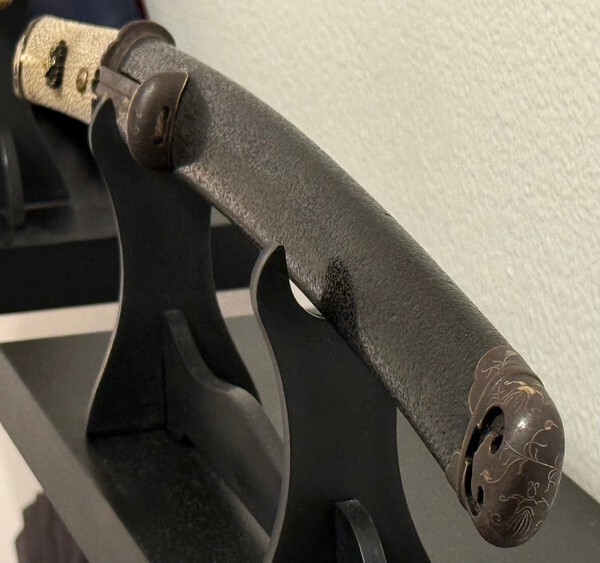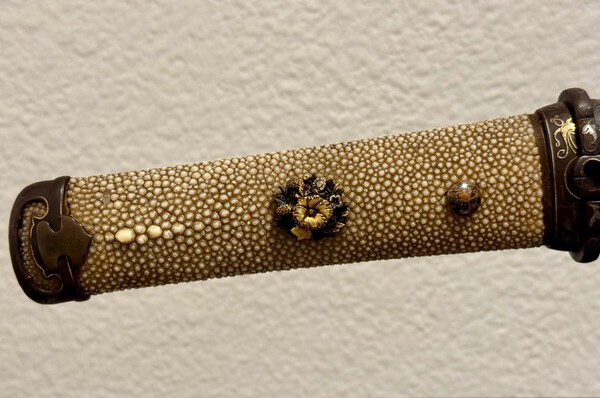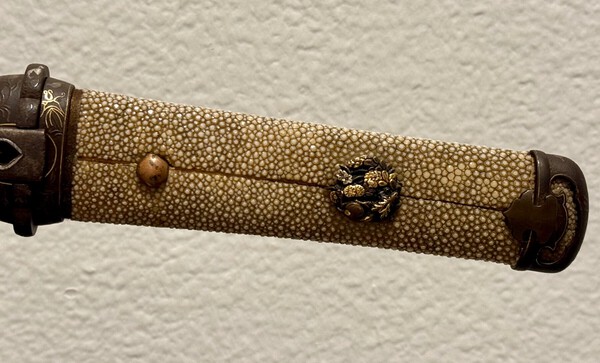-
Posts
532 -
Joined
-
Last visited
-
Days Won
2
Content Type
Profiles
Forums
Events
Store
Downloads
Gallery
Everything posted by Tcat
-

Advice for new collectors from an old dog
Tcat replied to Rayhan's topic in General Nihonto Related Discussion
You did not tick all the boxes. Where is mumei? Do it with suriage mumei Shinto and we’ll be impressed. -
Hi Geraint, As far as I can see, all of the better lit areas on this tsuba show the hallmarks the honzogan technique. Note the channels / recesses where the soft metal wire inlay is missing. If you zoom in on the left hand side of the image they are clearer. The right hand side doesn’t have enough light to make out the channels, but they seem consistent enough on the left of the image where inlay is missing Meanwhile, the subject matter and execution is very much in the style of kaga-zogan, so if not true kaga-zogan then I think it’s “in the style of kaga-zogan”. Here’s a couple papered examples along with an “anecdotal” example of what I consider to be classically representative of “kaga-zogan” (the rain dragon tsuba). Cheers 🍻
-

Advice for new collectors from an old dog
Tcat replied to Rayhan's topic in General Nihonto Related Discussion
yea, you’re making a really convincing case man -

Advice for new collectors from an old dog
Tcat replied to Rayhan's topic in General Nihonto Related Discussion
Was it your really your magnanimous efforts to share your knowledge and wisdom with others which were treated with distain, or was it the fact you were trying to preach to others about how they really ought to be spending their money, meanwhile showing your own distain for those who don’t follow your definition of the correct process? Genuinely curious as to how you came to feel that way because from what you’ve posted here on NMB you come across as pretty disdainful of most Japanese swords and the people interested in them. -
Not very straight-shooting to call it “fantasy dreaming”, nor to dismiss imagination in this hobby Imagination is what gives collecting its heartbeat. If you strip away the imaginative, emotional connection, you reduce it all to a bean-counting exercise... Speaking personally, where's the fun in that? There are multiple dimensions of value in nihontō. Careful attribution, documented provenance, papered examples, and study of workmanship are vital because they keep the discipline honest and preserve swords both as art objects and cultural history. However, no less legitimate is the enjoyment or value gained from indulging in the imagination and romance of these weapons as living artifacts. To hold a mumei Sukesada is still to hold a piece of steel that may well have been in battle, accompanied a person along a dangerous journey or been part of a single family’s history for generations. That connection to the lives and deaths of ordinary people from years gone by, not just daimyo or the most celebrated smith of the time, is still powerful. Meanwhile, scholarship and romance are not always opposed. Horses for courses.
-
Nowadays we have more resources than ever and can instantly see in high resolution what once required a trip to Tokyo. Meanwhile, one can compare a sword against dozens of papered examples located all over the world in a single evening. The magic has become the thrill of knowledge, the ability to access what had been locked behind language and geography, and connecting with other collectors, experts and enthusiasts all over the world. These all involve a certain amount of skill, albeit not quite the same as poking through attics and thrift stores. Kurosawa films once drew collectors to the romance of the samurai, but the last decade has seen anime (Touken Ranbu), video games (Ghost of Tsushima, Nioh), and film franchises (The Last Samurai, 47 Ronin) breathe contemporary life into Japanese swords as a cultural icons. An impactful moment from any of these media has the potential to create the desire to hold the real thing. For some, owning one becomes inevitable. I believe the importance of educating audiences with engaging and entertaining elements promoting Japanese swords cannot be overstated. Stories must be told. Without a narrative, these objects lose their context and meaning. In the case of post-war America, the context is in the name, but going forward it will be the tales we tell our children and our children's children about the Japanese sword which keeps the spirit alive. Those stories are already being told all over the world as we speak, and interest in Japanese swords is growing globally. This will perhaps not translate as directly to the pursuit of aquisition as it may have among a different demographic, but the bottom line is that the market is growing.
-
The mei reads kunitsugu.. manufacture time I would guess to be late muromachi. Other's opinions may differ. Good luck
-
For Sale $2,500 OBO - A waki-soshu koto o-tanto signed Hiromitsu 黄光 - likely from late generation (c.1550-1620) Hiromasa or Fuyohiro schools - as judged by a world famous US-based collector/dealer. The blade features a broad suguha, with o-itame hada and lively hataraki still prominent in the ji steel. The boshi is komaru. The blade has hi, with soe-hi on the omote and take-kurabe (futatsuji-hi) on the ura side. The nakago is ubu. The sword is mounted in a wonderful and original mid-edo issaku hira-zogan aikuchi koshirae, complete with wari kogai and kozuka. The decorative inlay on the iron ground is predominantly copper wire, originally silver-washed, forming vines and buds. Some of the silver wash is still present around the fuchi and on the koiguchi, which forms a false hamidashi. Gold zōgan resembling lily blossoms (yuri) appears in several places. The pierced kozuka features a phoenix and cloud design. Finely detailed menuki depict floral arrangements and natural scenes with sika deer in shakudō, gold, and copper. The tri-metal aesthetic of the koshirae (silver, gold, and iron) reflects high social status of the original owner. The saya is finished with a high quality kuro ishime style lacquer, and the overall craftsmanship, quality and condition of the mounts is very good. A copper compression-fit mekugi secures the mount, while an elegant copper habaki finished with antique gold wash completes the piece. Dimensions Nagasa: 31.25 cm, Sori: 0.64 cm Motohaba: 2.92 cm Moto-kasane: 0.65 cm Sakihaba: 2.22 cm Saki-kasane: 0.47 cm Blade Only Weight: 217.1g Mekugi-ana: 1 Total Weight: 506.5g Total Length of Koshirae: 53 cm Condition: Minor wear, losses and repairs to the koshirae consistent with age and use. The blade has a burst fukure near the habaki visible in the photos and video. On close inspection it can be seen that this flaw does not touch the ha or edge of the blade. More photos / video available on request. 5% of the total sale will be donated to NMB
-
For Sale - $1,800 OBO - A stunning and complete set of aikuchi fittings from the late edo period produced by a mainline Higo school. Ready for mounting or to be enjoyed as part of a display. Made from iron and decorated finely with gold karakusa and silver Kuyō-mon using the Higo-zōgan technique. The Kuyō-mon (sometimes known as Hosokawa-mon) represents the nine celestial bodies and was famously adopted by the Hosokawa family as their main crest. Filled “Kuyō” are associated with the manifest and material, while ringed Kuyō are said to represent the spiritual, or metaphysical. A striking arrangement of eighteen Hosokawa mon in silver, with nine filled Kuyō and nine ringed Kuyō, employ a symbolic harmony perhaps intended to embody a cosmic completeness or symbolic duality appealing to both aesthetic sensibilities and esoteric cosmology. The 7-piece set includes: • Fuchi • Kashira • Koiguchi • Kurikata • Kaeshizuno • Kojiri • Bashin (馬針), tempered and in old polish. The fittings show minor wear consistent with age but remain in excellent condition. The absence of NBTHK papers is offset by the clear quality of work, which speaks to a mainline Higo lineage, possibly Nishigaki or Hirayama school, executed in the late Edo period when such koshirae were prized by elite retainers and favored by the Hosokawa daimyō. Guaranteed to pass hozon with attribution to a Higo school. Additional photos available on request. Where successful sales are referred or closed on NMB, 5% of the total sale will be donated to Brian.
-
Incredible...and thanks very much.













.thumb.jpeg.a002b491d3de4baffd2423a5af5b3152.jpeg)





















.thumb.jpeg.df946de77e754f405f6681e18699c02f.jpeg)